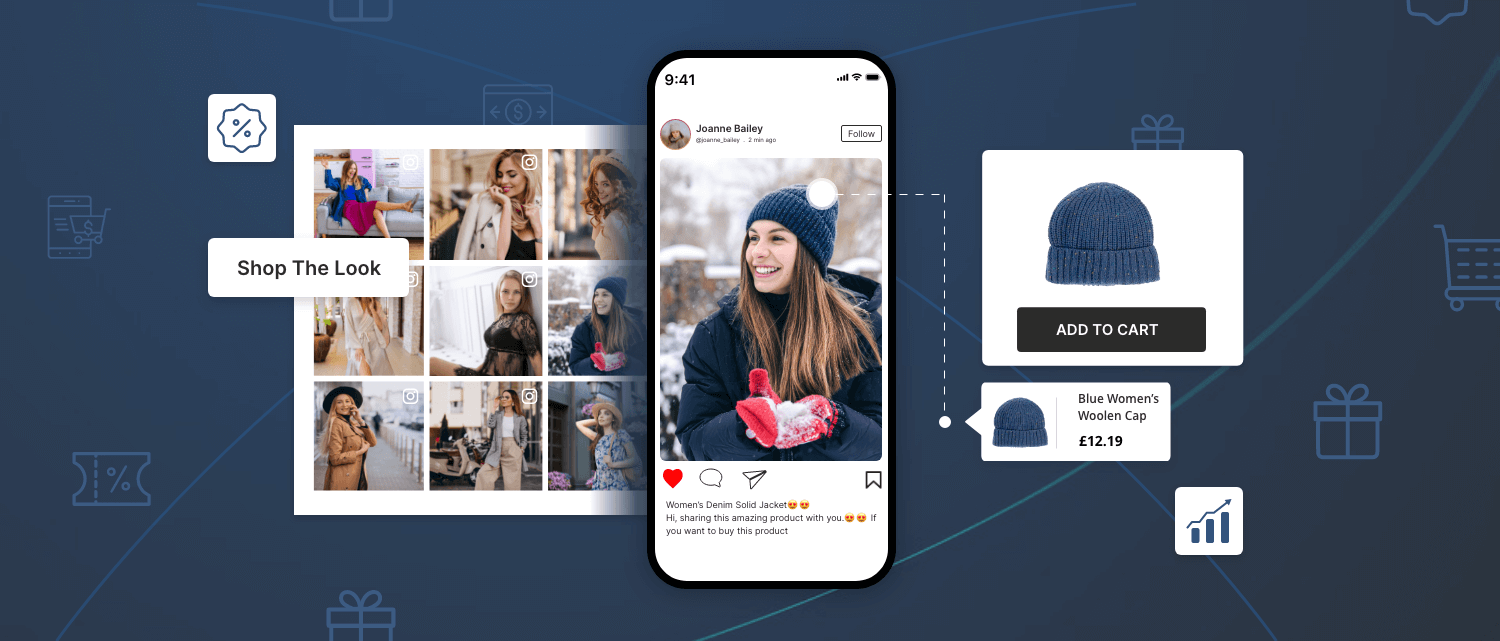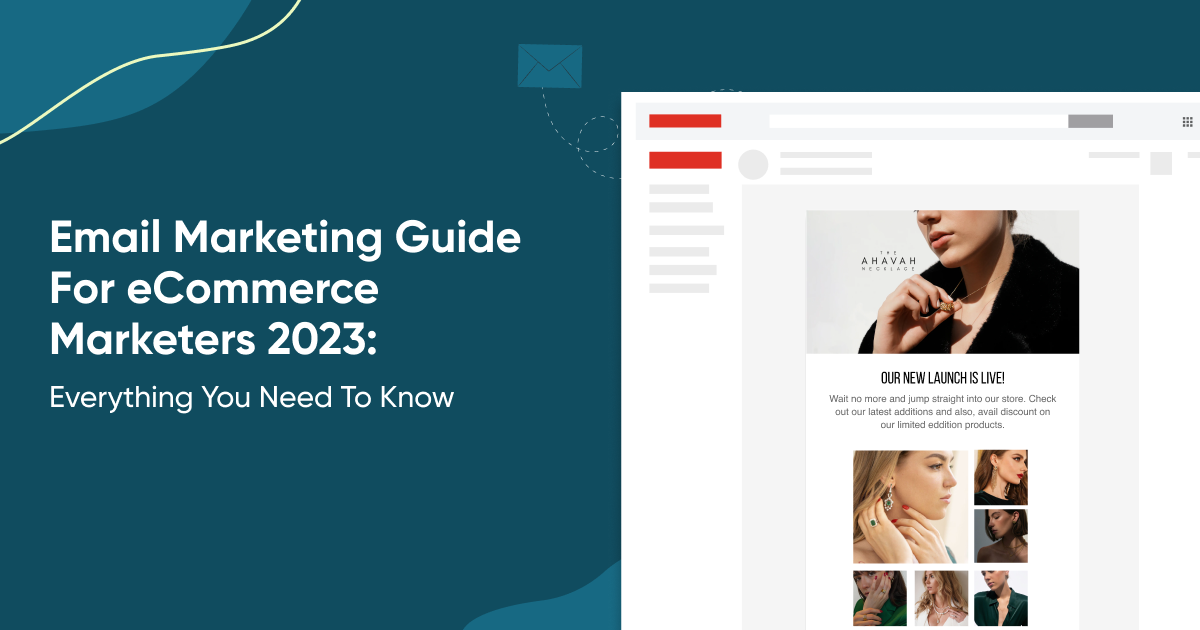ECommerce Marketing Guide: Types, Strategies, Tools & Examples
The only constant in eCommerce is change.
The ecommerce industry has changed more in the past two years than in the past two decades. With a massive increase in the number of channels businesses are selling on, competition, and diminishing returns on online advertising, how brands sell and consumers shop – has undergone major shifts.
The only way to stand out and take the lead is through omnipotent marketing.
Read the blog to know everything about eCommerce marketing and the 9 leading strategies you must take advantage of now!
What do you understand about eCommerce Marketing?
Tagshop defines eCommerce Marketing as the practice of promotional strategies to drive traffic to your online store, converting that traffic into leads and paying customers while retaining them post purchases.
Having a well-built, user-centric website will get you only halfway through your targets. You need to pave the way for brand awareness following a well-thought-out marketing plan to be completely there.
By creating a deliberate marketing plan, you can:
- Expand your brand’s reach and create opportunities to build better brand-shopper relationships
- Improve your ROI
- Evaluate The Market & Enhance Your Performance
- Map out the growth of your business
But to derive optimum results from Ecommerce marketing, reaching out to customers where they are is non-negotiable.
Read more about ecommerce video marketing examples.
Types of Ecommerce Marketing Strategies
1. Search Engine Optimization(SEO)
While you might not be able to game Google’s algorithm, they can still control how well their websites are SEO optimized.
Understanding the SEO business model is crucial, as a vast majority of shoppers, 87% to be precise – begin their product search leveraging digital channels. And if your brand doesn’t show up where the shoppers are, then the chances of losing them to your competitors are high.
The way you write content significantly impacts whether you use an AI writer to a professional, ensuring the inclusion of relevant keywords to match user search intent. For example, include specific terms like AI Tools for Java Developers to attract the right audience. Quality backlinks also play a crucial role in enhancing the authority and visibility of your content across search engines. To enhance your SEO strategy even further, understanding the significance of different domain extensions can be quite beneficial. Check out this article on .com versus .net to make an informed decision. To enhance your SEO for ecommerce even further, understanding the significance of different domain extensions can be quite beneficial. For example, if shoppers aren’t sure which clothing brand would provide for their needs, they will search, and if your brand surfaces, they will learn about your existence.
2. Pay-per-click advertising (PPC)
Pay-per-Click(PPC) is an advertising strategy where an ad publisher is paid for every user click on ads, which helps businesses gain new visitors. Crafting Ad Copy is crucial in PPC campaigns as it directly influences user engagement and click-through rates.
In today’s time, when people are turning to ad-blocking applications, PPC is still effective – as it can help boost brand reach, user engagement, interactions and build loyal communities.
Statistically speaking, PPC ads can increase brand awareness by 80%, which can prove to be extremely beneficial for small businesses. Partnering with experienced PPC ads agencies can help them navigate the complexities of campaign management and maximize their return on investment
3. Web Push Marketing
Web push marketing is a strategy that implies sending push notifications to the targeted audience.
Brands can send both transactional and promotional messages via browser or mobile development and consulting applications. This type of push communication strategy expands your reach, increases engagement, and keeps audiences informed about updates, such as the status of their package.
Though web push marketing is a traditional marketing method, it is still potent for eCommerce brands.
4. Social Media Marketing (SMM)
As the name suggests, social media marketing consists of running promotional activities on social media platforms.
Irrespective of the size of your business, SMM can be your go-to eCommerce marketing strategy, as it aims to increase brand awareness, engage with consumers and fans, open a channel of communication with them, build a robust brand-user relationship, and brand affinity.
In fact, with 4.5 Billion people using social media, it only makes sense for eCommerce brands to have a prominent presence on social channels to enable greater selling and revenue-earning opportunities
5. Chatbot Marketing
Consumers seek faster responses to their queries; their patience levels have hit rock bottom. By leveraging AI-powered Chatbots for eCommerce marketing, businesses can communicate with customers based on predetermined scenarios or through AI.
Chatbot marketing involves handling orders, ensuring customer success, and sharing updates and offers with customers. It can reduce overall support costs by 30%, making it beneficial for brands with a large user base.
6. Influencer Marketing
Scrolling through social media without coming across any influencer’s post is almost impossible.

Regardless of your eCommerce niche, partnering with influencers can help you reach your target audience, enhance brand awareness, and drive conversions.
89% of the marketers say that influencer marketing campaigns’ ROI is the same or better than other marketing channels like SEO or PPC.
7. Email Marketing
Any eCommerce marketing or digital PR strategy cannot be complete without email marketing.
While it might not receive the attention other marketing plans do, it can still yield a significant ROI when done right.

Send visually appealing emails with a catchy subject line to ignite the subscribers’ interest. Additionally, you can inform your customers of the items waiting in their cart, any upcoming discounts, giveaways, contests, or new product launches to keep them updated and in touch with your brand. To effectively implement ecommerce marketing strategies, a well-defined ecommerce team structure is crucial. Aligning this structure with each strategy—SEO, PPC, social media—ensures optimal execution with the right expertise.
Top Strategies Aligned With Current Trends To Beef Up Your Ecommerce Marketing
1. D2C Is Not Enough, Introduce Your Brand On Third-Party Platforms
With competition and customer acquisition costs only reaching new heights, brands must find new and efficient ways to reach shoppers. And for budding eCommerce brands with comparatively limited marketing budgets, it gets difficult to drive traffic and acquire customers.
Hence, introducing your retail brand on third-party platforms like Google, Facebook, and Instagram Shops can enhance brand awareness, product discovery, and sales. The best part? More than 60% of all product searches begin on third-party retail platforms.
2. Provide Consistent Experiences Across channels
Consumers’ shopping behavior is constantly altering. It has become more unanticipated and less intentional. According to Accenture, over 50% of consumers plan on using a mix of in-store and online shopping channels moving forward.
Hence, your eCommerce marketing strategy must provide a consistent user experience online and offline.
3. Consumers Seek For Authenticity, Now More Than Ever
90% of the consumers believe UGC influences their buying decisions more than brand-generated content. Similarly, 2/3rd of the users believe UGC creates a more trustworthy and authentic shopping experience.
eCommerce brands can leverage content generated by their existing users to foster credibility and trust in prospects’ minds and build a stronger brand-user relationship.

UGC + eCommerce
- Users’ Reviews & Ratings
User reviews are among the most valuable assets of businesses across niches. By showcasing shoppers’ authentic experiences with your brand, you can help them make smarter and more informed buying decisions.
Additionally, integrating these reviews on the checkout or category pages can drive enhanced sales and revenue for your online store by creating social influence and tapping into impulse.
- Visual UGC
Nothing can beat the power of visual UGC. They are dependable and real and can potentially ease the purchase anxiety of the potential shoppers.
Repurpose the content generated on Instagram, Facebook, and other social media platforms to deliver visually appealing and authentic shopping experiences on your website.

4. Privacy Changes Signifies The Role Of SEO
With the internet taking steps to become privacy-first, investing in organic discovery is something all eCommerce marketing strategies must focus on.
Google phasing out third-party cookies and Apple’s iOS14 update makes opting out of data sharing easier for customers. And it just is the beginning.
With these changes in mind, ad personalization and performance are expected to decline while its visibility getting restricted. Here, diversifying marketing strategies can be the best bet!
The role of Google SEO to attract customers can work up to reduce the dependency on ads.
5. Social & Visual Commerce Is On The Rise
The line between social media and eCommerce is getting blurred, indicating the rise of social commerce. The amount of time users spend on social media, especially by gen Z, has placed social commerce as an emerging trend eCommerce brands must strategize around.

The power has evidently shifted from brands and retailers to the people, and they seek authentic product visuals to know whether or not to incorporate them into their lives.
Brands like Aerie, Nike, ASOS, and Glossier are among the growing list of brands leveraging robust visual and social commerce strategies to boost sales.
6. Providing Personalized Customer Services
Implementing task management software, can help optimize customer support and ensure every inquiry is handled efficiently, creating a seamless and personalized shopping experience.
Further, with rising acquisition costs and customers trust’ and attention only harder to gain, delivering personalized customer services can make performance marketing effective and the foundation for sustainable growth.
Send personalized emails, repurpose user-generated visuals as shoppable posts for your online store or on social commerce, collect reviews and testimonials and incorporate them in social ads, send exciting push notifications, etc.
Remember: A brand worth talking about and sharing with peers is worth paying more for!
7. Nano & Micro-Influencers Have Their Moment
Not all brands have completely recognized nano and micro influencers’ potential. Studies show:
- Micro-influencers have 22.2 times more conversions than average consumers regarding what to buy than average consumers.
- 82% of consumers reported that they were highly likely to follow a recommendation made by a micro-influencer.
Typically, nano and micro-influencers give the ‘guy next door’ feeling and have a greater engagement rate when compared to macro-influencers.
- From a brand’s perspective, partnering with these categories of influencers can be cost-effective and provide them with better ROI potential.
- From a consumer’s perspective, they find nano and micro-influencers more reliable, trustworthy, and authentic. Hence, any recommendation from them can significantly influence purchase decisions.
8. Users Seek Faster, Quicker & More Efficient Processes
Don’t make your customers work to buy from you unless you want only traffic and not conversions.
With changes in users’ shopping patterns and behavior, eCommerce brands need to consider a frictionless shopping experience.
Moreover, providing a seamless checkout with minimum friction has become possible without so many one-click buy options, such as PayPal, Amazon, GooglePay, etc..
The quicker is your checkout process; the lesser are your chances of cart abandonment.
9. Shopping With AR on Social Media Is The New Dawn
With the growth of social commerce, AR(Augmented Reality) has been helping eCommerce brands to deepen customer engagement and imbibe personalization to the shoppers’ shopping experiences.
Though far from mainstream, AR is still showcasing the early potential to boost conversions on social media channels. Users are already playing around with AR filters to interact with each other.
Mentioning about platforms, Snapchat is the most advanced platform for AR, but Instagram is taking the lead. In addition, brands from the fashion and beauty industries have started considering AR shopping on social media, using applications like virtual try-on or product visualization.
It might not be the now, but it is definitely a strategy to consider to get technologically advanced in eCommerce and enhance sales.
Leading eCommerce Marketing Tools To Scale-up Your Business
From a plethora of eCommerce tools and platforms available, these 4 offer comprehensive solutions to build and market your eCommerce store.
1. MailChimp
Mailchimp provides eCommerce businesses with tools that can help sell products, reach new customers, and magnify growth.
Using MailChimp, you can:
- Market your business: Build emails, social ads, landing pages, and more to reach out to users following an omnichannel approach.
- Create Your Online Store: Build awe-inspiring websites with a custom domain or launch your store online while allowing customers to book appointments directly.
- Enable Automation To Your Marketing: Add a personal touch to automated marketing messages.
Additionally, the platform provides creative tools and audience insights that help drive traffic and boost sales to the eCommerce store. For broader marketing needs, businesses may also consider exploring Mailchimp alternatives for their email campaigns.
2. Google Analytics
Google Analytics is a valuable ally for an eCommerce marketing strategy to win consumers. The insights include information about your site, where your consumers came from, their behavior on your site, etc.
The most important sections you must consider:
- Real-time Reports: Track website traffic as it happens, which pages visitors are viewing, their geographical location, traffic sources, and conversions.
- Audience Reports: Know the total number of unique and returning visitors on your site, the total number of pages viewed, bounce rate, etc.
- Acquisition Reports: An acquisition overview will help you gather – which channels drive the most traffic, holds the audiences’ attention, and result in most sales.
- Conversion/Ecommerce Reports: By leveraging eCommerce tracking, you can learn more about which products customers buy and in what quantities, the amount of revenue generated, etc.
While widely used, Google Analytics isn’t the only option. There are several Google Analytics alternatives that offer different approaches to data collection, privacy handling, and reporting. Depending on your needs, exploring these alternatives can help you find a solution better aligned with your business or compliance requirements.
3. Tagshop
Pool all your visual user-generated content to the places you sell – webpages, emails, and social with Tagshop, a comprehensive solution for eCommerce brands, helping them create a full-funnel UGC suite.

Enable collecting, curating, and making the most influential and valuable UGC shoppable effortlessly with Tagshop to highlight the real-life value and customer satisfaction to attract, engage and convert.
Advanced solutions for shoppable Instagram, UGC, Product Page galleries, UGC lookbooks, on-site visual UGC uploads, and incorporating customer reviews and ratings in the buyers’ journey, Tagshop helps brands amplify their growth by enabling advocacy and maximizing customer value.
4. Shopify
Shopify’s eCommerce platform has everything you need to manage your business. It has comprehensive built-in tools and features and a library of third-party apps to help eCommerce brands simplify business.
- Sync all your sales and inventory data in a unified place.
- New order notifications, automated emails, and tracking information to stay updated with shipments.
- SEO tools that increase site speed and help brands optimize metadata for keywords.
- Secure systems that protect private data.
- Shopify works with credit and debit cards, PayPal, and over 100 other payment gateways to assist payment collection from mobile wallets and apps, in-person or online.
With over 1 Million merchants trusting Shopify, this eCommerce tool is as promising as it gets.
Leading Ecommerce Brands’ Marketing Strategies To Get Inspired From
1. ASOS
ASOS is an eCommerce website that powers its Instagram feed with users using its hashtag #AsSeenOnMe.
This enables the brand to engage its customers and inspire them to buy by getting its advocates(existing users) to speak for them. Hence, facilitating impulse purchases via ‘see it, want it’ motivation.
Further, a link to their eCommerce is added to let users directly buy products featured in the photos, guiding the users to a seamless shopping experience while maximizing sales.
2. Glossier
Glossier’s Brand Building by Limelighting Users’ Experience
The beauty brand decoded the power in customers’ voices in building a powerful brand-user relationship.
According to the founder Emily, it is Glossier’s users that will drive their sales, narrate its story, tell them what to build next and where to sell their products first.
From sharing user testimonials in stories, emails, websites to repurposing visual UGC in their marketing collateral, Glossier has leveraged the authenticity and social proof provided by users’ content to its fullest potential.
3. Daniel Wellington
Daniel Wellington strategically leveraged a blend of influencer marketing and user-generated content to build their brand’s identity and reach millions of consumers online who might not have otherwise known the brand.
As a part of their approach they:
- Laid focus on developing a brand story that would attract and inspire the audiences,
- gave away the product free of cost to the shortlisted influencers to promote their product, and
- curated an exclusive hashtag for the brand #danielwellington to prompt social media users to create and post content showcasing their products
- The best UGC content is then selected to repost Daniel Wellington’s Instagram account with the #DWpickoftheday
Over To You
What got eCommerce where it is now won’t get it to where its headed. So the need to create a more remarkable brand for consumers, like literally worth remarking upon – is becoming non-negotiable.
Assuming you got a head start, it is now time to accelerate and ace on your eCommerce marketing strategy!












